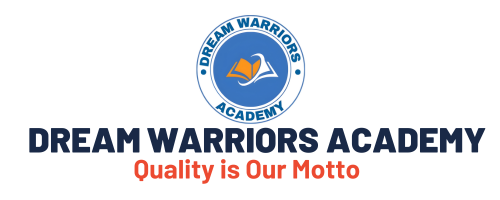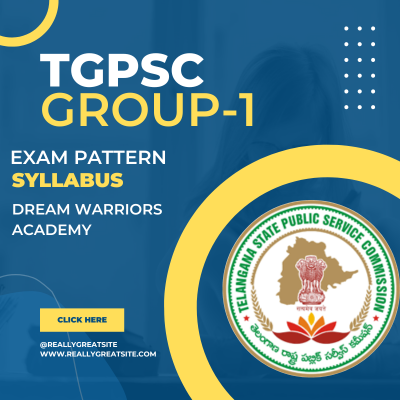TGPSC Group 1 Syllabus and Exam Pattern (Updated)
Telangana Public Service Commission (TGPSC) conducts Group 1 examination to recruit eligible candidates for various Group-1 posts in Telangana State. This TGPSC Group 1 Examination has two tier of selection process PRELIMS and MAINS.
TGPSC Group 1 Syllabus and Exam Pattern (Updated)
In Prelims examination has 150 Multiple Choice Questions (MCQ) for 150 Marks each right answer candidate will get 1 mark. Duration of the prelims examination is 2.5 hours. There would be no negative marks for each incorrect answer.

TGPSC Group 1 Prelims Exam Pattern:
| SUBJECT | DURATION (HOURS) | MAXIMUM MARKS |
| General Studies & Mental ability (Objective Type) 150 Questions | 2 ½ | 150 |
TGPSC Group 1 Mains Exam Pattern:
- TGPSC group 1 mains examination contents 6 Descriptive subjects
- English is qualifying is test and Marks will be not added to the merit list
- Duration of the each paper is 3 hours.
| SUBJECT | DURATION (HOURS) | MAXIMUM MARKS |
| General English (Qualifying Test) | 3 | 150 |
| Paper-I General Essay 1. Contemporary Social issues and Social Problems. 2. Issues of Economic Growth and Justice 3. Dynamics of Indian Politics 4. Historical and Cultural Heritage of India 4. Developments in Science and Technology 5. Education and Human Resource Development. | 3 | 150 |
| Paper-II – History, Culture and Geography 1. History and Culture of India, with special reference to Modern Period (1757 to 1947 A.D) 2. History and Cultural Heritage of Telangana 3. Geography of India and Telangana | 3 | 150 |
| Paper –III – Indian Society, Constitution and Governance 1. Indian Society, Structure, Issues and Social Movements 2. Constitution of India 3. Governance | 3 | 150 |
| Paper –IV – Economy and Development 1. Indian Economy and Development 2. Telangana Economy 3.Development and Environmental Problems | 3 | 150 |
| Paper- V – Science & Technology and Data Interpretation 1. The role and impact of Science and Technology 2. Modern Trends in application of knowledge of Science 3. Data Interpretation and Problem Solving | 3 | 150 |
| Paper-VI – Telangana Movement and State Formation 1. The idea of Telangana (1948-1970) 2. Mobilisational phase (1971 -1990) 3. Towards formation of Telangana State (1991-2014) | 3 | 150 |
| TOTAL | 900 |

TGPSC Group 1 Prelims and Mains Examination Syllabus:
TGPSC conducts Groupon examination group 1 examination in Telangana state. Below we provided syllabus for TGPSC group 1 examination both prelims and mains.Follow the given below syllabus and start your preparation
TGPSC Group 1 Prelims Syllabus:
- Current Affairs – Regional, National & International.
- International Relations and Events.
- General Science; India’s Achievements in Science and Technology.
- Environmental Issues: Disaster Management- Prevention and Mitigation
Strategies. - Economic and Social Development of India.
- World Geography, Indian Geography and Geography of Telangana state.
- History and Cultural Heritage of India.
- Indian Constitution and Polity.
- Governance and Public Policy in India.
- Policies of Telangana State.
- Society, Culture, Heritage, Arts and Literature of Telangana.
- Social Exclusion: Rights issues such as Gender, Caste, Tribe, Disability etc. and
inclusive policies. - Logical Reasoning: Analytical Ability and Data Interpretation.
TGPSC Group 1 Mains Syllabus:
Check the TGPSC group 1 main examination syllabus for the general English, General essay, history, culture, Indian geography, society, Indian Constitution And governance, Economy and development, data interpretation, Science science technology, Telangana movement and state formation
General English (Qualifying Test):
- Spotting Errors – Spelling; Punctuation
- Fill in the blanks – Prepositions; Conjunctions; Verb tenses
- Re-writing sentences – Active and Passive voice;
Direct & Reported Speech; Usage of Vocabulary - Jumbled sentences
- Comprehension
- Précis Writing
- Expansion
- Letter Writing
PAPER-I: GENERAL ESSAY:
Section-I
- Contemporary Social Issues and Social Problems.
- Issues of Economic Growth and Justice.
Section-II
- Dynamics of Indian Politics.
- Historical and Cultural Heritage of India.
Section-III
- Developments in Science and Technology.
- Education and Human Resource Development.
PAPER-II: HISTORY, CULTURE AND GEOGRAPHY:
I. History and Culture of India, with special reference to Modern Period
(1757 to 1947 A.D.)
- Early Indian Civilizations-Indus and Vedic; Emergence of Religious Movements
in the sixth century BC – Jainism and Buddhism; Indo- Greek Art and
Architecture – Gandhara, Mathura and Amaravathi Schools; Social and Cultural
condition under the Mauryan, Satavahanas and Guptas . - Advent of Islam and its impact on Indian Society – Nature and significance of
Bhakti and Sufi Movements; Contribution of Kakatiya, and Vijayanagara rulers
to Language, Literature, Art and Architecture: the contribution of Delhi Sultans
and Mughals to Language , Literature, Art, Architecture and Fine Arts,
Monuments; Emergence of Composite Culture in the Deccan and India. - The Establishment of British Colonial Rule in India: Carnatic Wars , Battle of
Plassey, Anglo- Mysore, Anglo-Maratha and Anglo-Sikh Wars; Economic
Impact of British Colonial Rule: Land Revenue Settlements in British India; –
Commercialization of Agriculture; Rise of Landless Agrarian Labour; Famines
and Poverty;De-industrialization; Decline of Traditional Crafts; Drain of Wealth;
Growth of Trade and Commerce- Economic Transformation of India; Railroads,
Transport and Communication Network- Telegraph and Postal Services. - Anti – British uprisings: Tribal and Peasant revolts in the Nineteenth CenturyCauses and Consequences of 1857 revolt. Factors responsible for the rise of
Indian Nationalism; Rise and Growth of Socio- Religious and Anti-Caste
Movements: Brahma Samaj, Arya Samaj, Aligarh Movement, Satya Shodak
Samaj, Jotiba and Savithribhai Phule, Pandita Ramabai, Narayana Guru,
Ayyankali, Annie Beasant; Non- Brahmin, Justice and Self-Respect Movements:
Periyar, Mahatma Gandhi, Ambedkar and others. - Three Phases of Indian Freedom Struggle, 1885-1947. The rise and growth of
All India Kisan Sabha, Workers and Tribal movements; Issue of Gender and
Women’s movement; Growth of Socialist and Communist Movements; Growth
of Communalism; Independence and Partition of India.
II. History and Cultural Heritage of Telangana:
- History and culture of Ancient Telangana – Satavahanas, Ikshvakus and
Vishnukundins; Rise and growth of Jainism and Buddhism; Socio-Cultural –
Conditions- Language, Literature, Art and Architecture. - Medeival Telangana and the emergence of composite culture – Kakatiyas and
Velama kingdoms and their contribution to Socio- Cultural Development,
Literature, Music, Dance, Art and Architecture; Qutub Shahis and their
contribution to Telugu literature, art and architecture. Protest Movements against
Kakatiyas and Qutub Shahis- Sammakka Sarakka and Sarvaipapanna - The Establishment of Asaf Jahi Dynasty – Salar Jung Reforms and
Modernization of Telangana ; Socio- Economic development under the Nizams –
Land Tenures and Social System, Jagirdars, Deshmukhs etc.and Vetti– British
Paramountcy and Nizam- Revolt of 1857 in Hyderabad and the role of Turre Baz
Khan; Socio- Economic Development during the rule of the sixth and seventh
Nizams – Growth of Railways, Transport and Communication System,
Establishment of Industries, Educational Institutions – Monuments of Asaf Jahi
period. - Socio-Cultural Awaking in Telangana- Andhra Sarasvath Parishat – Literary and
Library Movements; Establishment of Nizam Rashtra Andhra Jana Sangham –
Andhra Mahasabha – Social Reform Movements -Brahma Samaj, Arya Samaj
and Adi- Hindu and Dalit Movements, Role of Bhagyareddy Varma- Andhra
Mahila Sabha and the growth of Women’s Movement. Role of Hyderabad State
Congress and Vandemataram Movement. - Peoples Movement against the Nizam’s Rule – Adivasi revolts – Ramji Gond and Kumaram Bheemu – Telangana Peasants Armed Struggle – Role of Andhra Mahasabha and the Communists –Majlis-Ittehadul-Muslimeen Party, Rajakars and Kasim Razvi – Police Action and the End of Nizam’s Rule – Integration of Hyderabad State into Indian Union.
III. Geography of India and Telangana:
- India – Physical setting, Physiography, Drainage, Climate- Mechanism of
Monsoon, effect of El-Nino and La Niño, Rainfall variability- Floods and Drought,
Soils, Vegetation and Wildlife-Degradation and Conservation Measures. Major
Minerals and Energy Resources- distribution and conservation, Energy Crisis –
role of non-conventional energy resources. Marine Resources – Economic
significance, EEZ. Water resources – availability, problems of inter – state Water
sharing, Conservation Measures.
- Agriculture and Irrigation – Major Food and Non-Food crops, Agro Climatic
Regions, Green Revolution, recent trends in Agriculture; Major Irrigation Projects
and Command Area Development; Industries- Major Industries – Iron and Steel,
Cotton Textiles, Cement, Sugar, Automobile, IT, & Food Processing Industries,
Localisation Factors, Industrial Corridors & Economic Development;
Transportation: Means of Transportation, Role of Road and Rail Network in
Economic Development, Highways and Express Highways; Major Ports –
changing trends and direction of India’s Trade – role of WTO; Strategic location of
India in the Indian Ocean; Population – distribution, growth, Demographic
characteristics, Demographic dividend and transition, HDI, Population problems
and Policies. Urbanisation process- Spatial pattern, growth of Megacities,
problems of Urban Growth and Policies, concept of Smart Cities. - Geographical extent of Hyderabad State and present Telangana State Physical
setting, Relief, Climate, Rivers, Soils, Forest cover and Wild life–distribution,
depletion and conservation. Minerals and Energy resources – Coal, Iron and
Limestone distribution. Thermal and Hydro Power Projects – Problems and
Prospects. - Agriculture- Rainfed/Dry land Agriculture, Drought prone areas and Mitigation
Measures. Sources of Irrigation: Canals, Tanks and Wells, Depletion of Ground
Water and its conservation- Mission Kakatiya. Industries – Cement, Sugar,
Pharma, Electronic, Tourism, IT, ITIR, SEZs. Handicrafts and Household
Industries and their problems. Road and Rail Network distribution and role in
Economic Development. Population – distribution, growth, density, demographic
characteristics (sex ratio, age, literacy, etc.,) Tribal Population – distribution,
problems of Tribal areas and policies for Tribal Area Development. - Urbanisation in Telangana State, Spatio-temporal changes, Urban Growth and
Migration. Evolution and phases of Urban Growth of Hyderabad, transformation
from historical to modern cosmopolitan Megapolis, Primacy of Hyderabad in
Telangana State, City structure, Industries and Industrial estates, urban
infrastructure and transport – ORR and Metro – Problems and Planning – role of
GHMC and HUDA (Metropolitan Development Plan – 2031, HMDA), Hyderabad
as a Tourist Centre and Global city


Leave a Reply